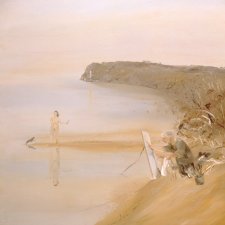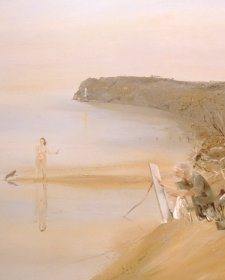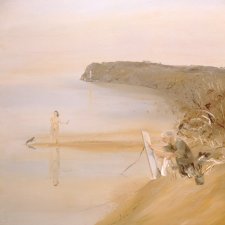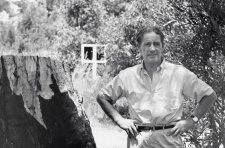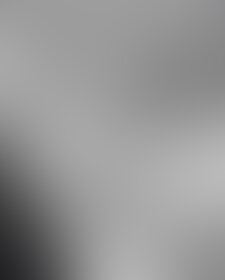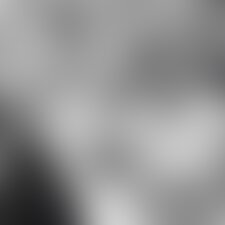In 1965, at the height of his international reputation, Sidney Nolan said; ‘Art is a dialogue between the artist inside himself and the exterior world. On the other hand’ he added, ‘art as a career is a public exposure. These two points of view must be synchronised. A public image is not to be received without circumspection.’
The underlying tension between the artist’s inner life and the persona the artist adopts in the world is strikingly portrayed in Nolan’s last self-portrait, Myself. The work is one of two self-portraits painted in 1988 included in the National Portrait Gallery’s exhibition Nolan Heads. In both of these paintings the artist presents himself as urbane and slightly distinguished, with collar and tie and the look of easy good manners for which he was well known. Yet in Myself he is portrayed trapped behind a vigorously, almost angrily, painted shadow of the image of his most famous creation, the Kelly head.
Myself was the last of a series of self-portraits Nolan painted between 1943 and his death in 1992. These self-portraits share a characteristic common to many artist’ self-portraits; they are objects of self-definition, occurring at points in an artist’s career which, in retrospect, seem pivotal in journeys of artistic discovery.
In Nolan’s 1943 self-portrait now in the Art Gallery of New South Wales, we can see evidence the quest for Nolan’s self-definition as an artist during this crucial early period in his development. Dated March 1943, the picture was painted in the Victorian country town of Nhill where the artist was stationed for several months during his two-odd years of army service. The painting is clearly a statement that the subject is an artist, not a soldier – with the head wedged in a plane between a palette, with its spray of brushes, and the red wall behind, with two Nolan landscapes hanging on it. Yet the bold strokes across the forehead have been described as a kind of war paint (by Drusilla Modjeska, in her book Stravinsky’s Lunch 1999, where she touches on the comparison of this work with other less self-declaring portraits by Nolan’s contemporaries).
There is a hint of sombre, melancholy mood in the 1943 painting which may reflect Nolan’s frustration during his enforced Wimmera sojourn. But what makes this self-portrait particularly fascinating is the way in which the artist brought his interest in the formal problems of painting the landscape into portrait painting. In a letter sent to Sunday Reed from Nhill, Nolan refers to an article he had read by Robert Melville on Picasso’s portraiture (in the November 1942 issue of Horizon): ‘Melville... says that Picasso used African scarification and Maori markings in his painting of faces. It cleared up some point that was worrying me I think... It seems necessary to impose images on the faces and not around them.’
In the 1943 self-portrait the images imposed on the face create a landscape: in the lower part we can read the rooftops and smoking chimneys Nolan has been painting in Ballarat; the eyes are blue Wimmera lakes; and above them are furrowed horizons of wheatfields and the desert beyond. It is another version of the deliberate flattening of distance and merging which is given clear definition in other paintings of March 1943.
Art historically we are tempted to leap from the brilliant explorations of landscape in the Wimmera to the virtuoso performance of the Kelly paintings. Yet there was a series of highly significant paintings in between. Immediately after the war Nolan painted a series of autobiographical pictures, a poignant attempt to recover some lost continuity in life in which flashes from his childhood are recalled. Nolan said many years later: ‘After I left the army, like a lot of others, I tried to recapture things, to see things again, to re-experience them.’ In Giggle Palace 1945 he re-experiences a childhood visit with his parents to the photographer’s booth at Luna Park in St Kilda. This is a remembered self-portrait, imagined as part of a story. Meaningful personal narratives are embodied in all the 1945 paintings; they are precursors to Nolan’s paintings of a story imbued with complex personal symbolism – the Ned Kelly story.
There can be no doubt that Nolan considered the Kelly paintings of 1945-47 to be autobiographical, but in what respect these pictures are autobiographical is not an easy question to answer. We can find hints to what we know of the dynamics of Nolan’s personal life during the time the pictures were made – when he was living at Heide with John and Sunday Reed. But there was clearly some broader self-identification with the character of Kelly – and various suggestions have been made: the painter’s being ‘on the run’ after what was technically desertion from the army in 1944; his desire to be a rebel poet (as he regarded Kelly) and his identification with Kelly’s Irishness.
One of the most enigmatic, but until recently, least known of the Kelly paintings of 1945 bears the title Ned Kelly: ‘Nobody knows anything about my case except myself’ The quotation is something Kelly said at his trial. If the Kelly series is autobiographical, the title is revealing; the ultimate self-representation in Nolan’s Kelly paintings may well be a kind of hide-and-seek game. The man is in the world, there for everyone to see, but he is masked, his motivations and thoughts private, and his actions susceptible to misunderstanding.
Apart from the enigmatic self-reference of the Kelly paintings, Nolan painted at least two direct self-portraits in 1947, in a series of remarkable paintings of heads of friends and acquaintances now in the Art Gallery of South Australia. Many years after he had painted them, Nolan described these as ‘unflattering’ portraits. The self-portraits are not particularly unflattering – indeed they are faces devoid of meaning. Except for the eyes. The searing blue eyes with fried-egg whites are a motif which appeared first in the 1943 self-portrait, and in the painting of a hare caught in a trap of 1946 (which Nolan described as a symbolic representation of his father) and in one of the 1988 self-portraits. Nolan’s belief in the role of the artist as a recorder of the seen world first-and-foremost is the message of these huge and intense eyes.
In 1986, and approaching 70, Nolan painted the very large and retrospective Self-portrait in youth – an imagined head in every sense different from the direct self-portraits painted early in his career. Nolan described the 1986 work as ‘a tonal homage to Hugh Ramsay’. The self-portrait was the chief subject of Ramsay’s short and brilliant career at the beginning of the 20thcentury. Nolan alludes to the smoky tonalism of Ramsay’s style – but surely he is using this sfumato symbolically, telling us that his own life and identity as a young artist is so obscured and smudged that it is now impossible to see it with any clarity. Furthermore, Ramsay died young, so all his important work was done while he was in his youth. This is what many critics began to chorus about Nolan in the 1970s; it remains one of the statements most often made (misguidedly in my view) about the shape of Nolan’s career.
To some extent the final self-portrait of 1988 is an address to those critics who saw him as having achieved nothing of greatness after Kelly. Or perhaps it was addressed to those, like his one-time friend Patrick White, who mocked what they saw as the artist’s incongruous adoption of the mask of rebellious Kelly and the cloak of English public success.




